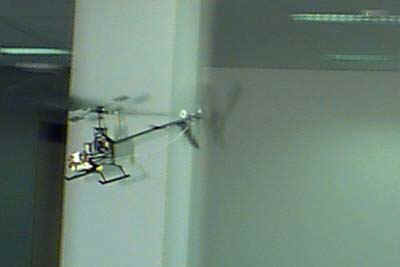|
The first try |
 |
Rotor: 37 cm
Weight: 125grams (4.5 ounces) with 8 cell 50mAh, 129 grams with canopy
Radio: 4 channel FM, Futaba FC28 (TX), Yellow6 (RX)
Speed controllers: 1.7 gram Jung (WES)
Flight time: 2 minutes with 50 mAh pack, 3 minutes with 75 mAh
Materials used: all carbon, except mainrotor (balsa covered with ultra-light glass-fiber cloth)
First flight performed in March 1997
 |
This Helicopter is a 100% own design. All the mechanical pieces were handmade, including rotorhead, swashplate and so on. Roughly 95% of the frame is made of carbon. The blades are balsa covered with glass fiber. The tailrotorblades are carbon. All components were first tested on a test-bench. Most of the time went into designing the rotorhead. It was crucial to determine the correct combination of rotor dimensioning (span and chord), pitch, RPM, gear reduction ratio, motor and battery selection. The challenge was to get maximum lift at minimal power input. Currently, the Pixel I hovers at 12 Watt. |
 |
This shows that the Pixel is rather stuffed with electronics. You may appreciate the dual flapping rotorhead and the landing gear, all done with carbon fiber. I needed magnifying glasses to put some of these components together. The receiver is a 6 channel FM unit from YELLOW (Austrian product). I stripped off the case, the connectors, some of the printed circuit, the X-tal plug-in connector, replaced the antenna with very thin and shorter wire. Net result is an 8-gram receiver. Where you see the two white dots on the far left is the Piezo Gyro. It is a standard Icarus Piezo that after some diet got out at 5.3 grams. To the right are two speed regulators piggy backed. One is for BEC and rotor RPM. The other is for tailrotor RPM (directional control). Left and right of the frame one can detect the two little motors that drive the rotor. Weight is 10 grams each. |
 |
A closer look at the gearbox. It is a two stage reduction box, driven by two motors. The gearbox is the central mechanical piece that slides in the frame. This concept is not unlike with the Kavan Jet Ranger some 25 years ago... The unit is all ball-raced, the supporting axes are carbon rods, and the torsion stiffness is almost like the one of a sugar cube! Here, on top of the magnifying glasses, I needed a needle to push the components in the right spot. All gluing (the whole model) was done with ZAP (green, red and black) |
 |
Behind the main motor, you can see a smaller electrical motor. This is the base of the servo's from WES-Technik. These are fully proportional, are delivered in an assembly kit, work perfectly and are only 3.7 gram 'heavy'. The Pixel includes two of these to drive the swashplate. Battery pack is 8 cells 50 mAh. Note that the electrical motors, the servos, the gears, the batteries, the carbon, the speed regulators and tons of good advice came from Mr. Scholl from WES-Technik. I recommend strongly visiting his site for all who wish to go into Micro-modeling. The more that his level of service is beating the highest standards. Mr. Scholl even released servos at 2.7 grams now. |
 |
The canopy is an important design element. Without it, the helicopter has no 'soul'. Listening to how people react, I may be happy with the looks. People look at the Pixel almost as to a living creature. However, beyond the fact that it is always a challenge to make a plastic canopy 'at home', this thing caused some specific problems. First off all, it is still too heavy (currently 4.3 gram). Second, the surface seen from the top is quite considerable. This gives some annoying turbulence when hit by the downwash from the rotor. I needed to add a very small tailplane to counter that. Talking about weight, I learned to take a new perspective. On a helicopter that small, every gram is about the equivalent of 50 grams on a 'normal' model helicopter. Who would not want to make his heli 200 grams lighter? That is the same as 4 grams less on mine. One anecdote: I had designed a very light swashplate at 6 grams. Two months later, I made a new one at 3 grams... In this whole project, the micro-scale (0.1 gram precise) was a crucial tool. Did you know that a receiver X-tal weights about 1 gram? That is on the Pixel as much as adding a servo to your big RC-Chopper! |
 |
Off course, this is what it is all about. It flies indeed. The first evening it was able to do very short 'hops' in my living room. It was not very stable. Then I could not get it better and was afraid that this was the price of the very small size. The next day, I remembered that the Pixel was still a helicopter, and that the problem may have to do with the rotor design itself. I changed one thing, and got immediately a rock solid hovering, just like the bigger brothers. For the specialists amongst you, I had added damping rubbers to the flapping hinge. That did not seem to work because it caused cross coupling between the two swashplate commands. Gyroscopic precession was not at 90 degrees. I simply removed the dampers and that was it. The longest flight (without touching ground in between) to date was 94 seconds. I think it must be possible to go beyond two minutes. |
| Go to the top of the 'Pixel I' showroom |